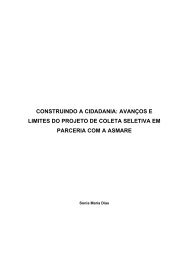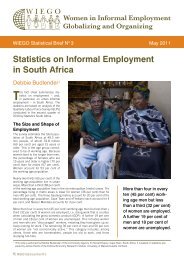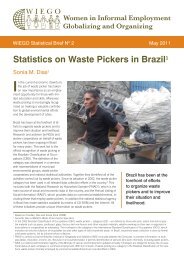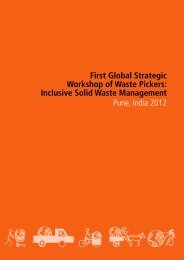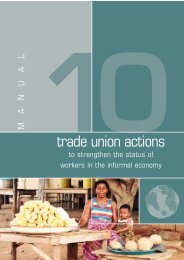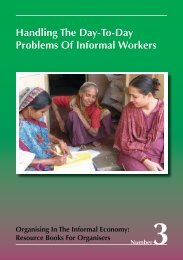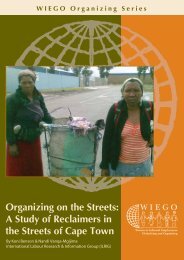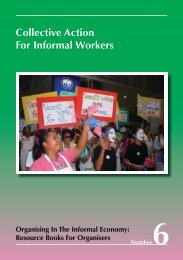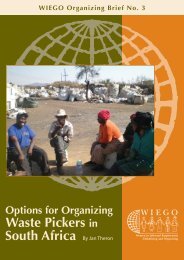Informal Economy Budget Analysis in Philippines and ... - WIEGO
Informal Economy Budget Analysis in Philippines and ... - WIEGO
Informal Economy Budget Analysis in Philippines and ... - WIEGO
Create successful ePaper yourself
Turn your PDF publications into a flip-book with our unique Google optimized e-Paper software.
<strong>WIEGO</strong> Work<strong>in</strong>g Paper N o 12Quezon City’s l<strong>and</strong> area <strong>and</strong> populationQuezon City (QC) is the largest LGU, both <strong>in</strong> l<strong>and</strong> area <strong>and</strong> population, with<strong>in</strong> Metropolitan Manila. Thelatter, commonly referred to as the National Capital Region (NCR), is composed of seventeen highlyurbanisedcities <strong>and</strong> one peri-urban municipality. QC’s l<strong>and</strong> area of 161.1 sq km comprises 25.3% of MetroManila’s total l<strong>and</strong> area of 636.00 sq km. The second largest, which is Paranaque City, has only 47.7 sqkm. 26 QC has 142 barangays or villages distributed <strong>in</strong>to four political districts.Likewise, with 2.68 million people, Quezon City not only has the largest population <strong>in</strong> Metro Manilabut also of all cities <strong>in</strong> the country. With a population density of 16,634 per sq km, it also has the thirddensest population among the country’s LGUs. The city has more female (51%) than male (49%)<strong>in</strong>habitants. Among the 1.36 million females <strong>in</strong> 2007, 58.7% or 802,194 are of reproductive age of 15–49 years old. NSCB has noted that from the years 1995–2000, QC had a high average annual populationgrowth rate of 1.9% compared to NCR’s 1.0% but the rate is slightly lower than the national averageof 2.4%. QC also has a relatively young population with about 52.3% who are less than 25 years old.(National Statistics Office, 2007)The Plight of the poor <strong>and</strong> the <strong>in</strong>formal economy workers <strong>in</strong>Quezon CityDespite the supposed blossom<strong>in</strong>g local economy, the majority of the people <strong>in</strong> the city are poor. Basedon projections for 2008, the total number of households fall<strong>in</strong>g below the poverty l<strong>in</strong>e, which was setby NSCB at PhP8,857 for the city, would reach about 156,348. There is a great disparity <strong>in</strong> <strong>in</strong>comedistribution among households with<strong>in</strong> the city. More than 16 percent (16.4%) of families belong to theupper <strong>in</strong>come group <strong>and</strong> registered a very high average monthly <strong>in</strong>come of about PhP107,607 whichis way above the <strong>in</strong>come of the middle <strong>and</strong> lower-<strong>in</strong>come families posted at PhP28,913 <strong>and</strong> PhP7,765,respectively. Among the poor <strong>and</strong> these lower-<strong>in</strong>come families are the 218,375 <strong>in</strong>formal settlers def<strong>in</strong>edas l<strong>and</strong>less <strong>and</strong>/or homeless people <strong>in</strong> the city, accord<strong>in</strong>g to the QC Urban Poor Affairs Office 2007Report. (Quezon City, 2005)With its grow<strong>in</strong>g population, adequate employment <strong>and</strong> susta<strong>in</strong>able livelihoods rema<strong>in</strong> among thebiggest challenges for the Quezon City government. The unemployment rate is 14.3%, which is lowerthan similar highly-urbanised cities of Manila <strong>and</strong> Makati <strong>and</strong> NCR’s average rate of 16.9%. However,it is higher than the national unemployment rate of 10.6%. (National Statistics Office, 2007) Giventhis situation, many are forced to engage <strong>in</strong> small-scale entrepreneurial activities that are mostlyunregistered, unregulated <strong>and</strong> not monitored. They form the workers <strong>in</strong> the <strong>in</strong>formal economy: homebasedworkers, carpenters, electricians, laundrywomen, beauticians, mechanics, street vendors, watchyour-carboys, drivers, <strong>and</strong> waste collectors.Of the city’s estimated 2.68 million residents, about 1.3 million are work<strong>in</strong>g or formally employed. Some250, 000 are still look<strong>in</strong>g for work or are counted among the <strong>in</strong>formal economy workers engaged <strong>in</strong> smallscaletrad<strong>in</strong>g, vend<strong>in</strong>g, food process<strong>in</strong>g <strong>and</strong> garment mak<strong>in</strong>g or service enterprises. Most of them arewomen who br<strong>in</strong>g food to their families’ tables <strong>and</strong> persevere to send their children to school. Of these,many are migrants who moved to the city from the rural prov<strong>in</strong>ces search<strong>in</strong>g for a better life, <strong>and</strong> who startout with <strong>in</strong>comes below the poverty level. 27In the impact study conducted by Mr. Clarence Pascual for the International Labour Organization (ILO)-Philipp<strong>in</strong>e Office <strong>in</strong> 2005 (Pascual, 2009), it was estimated that there are 52,500 workers <strong>in</strong> the <strong>in</strong>formal26http://www.mmda.gov.ph/ma<strong>in</strong>.html, retrieved May 15, 200927‘Puhunang Pangkaunlaran ng Sikap Buhay Programme’, Information Materials from the Sikap Buhay Entrepreneurship <strong>and</strong>Cooperative Office (SB ECO), Quezon City, 200920



